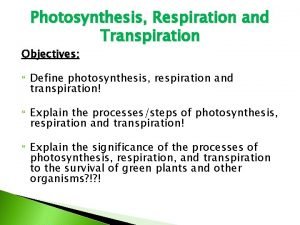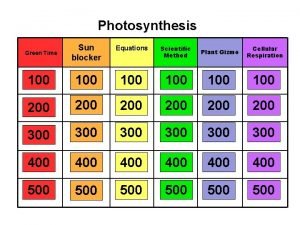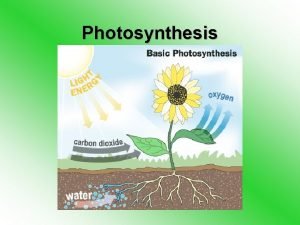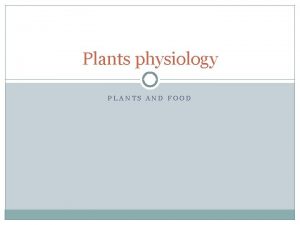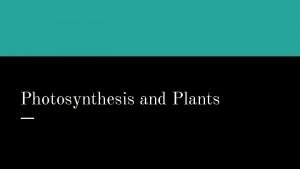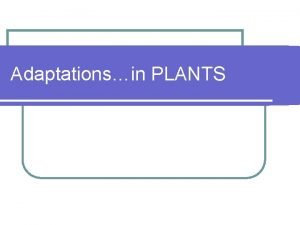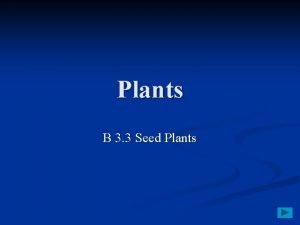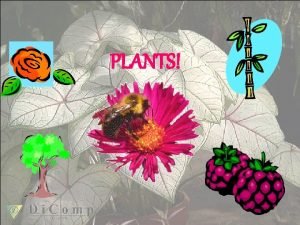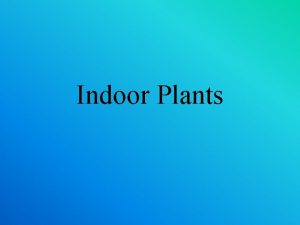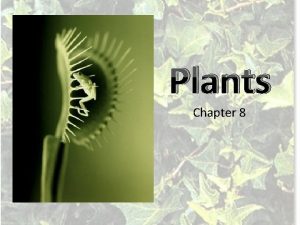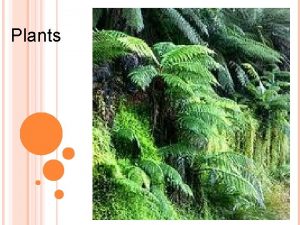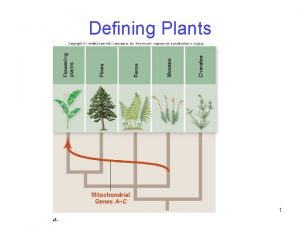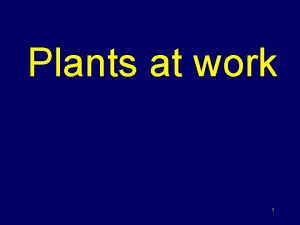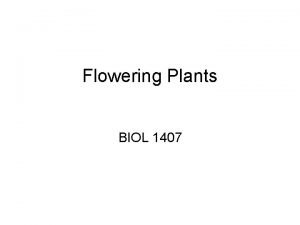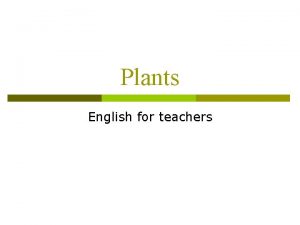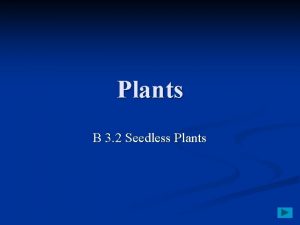Photosynthesis Photosynthesis Photosynthesis is the way that plants





































- Slides: 37

Photosynthesis

Photosynthesis • Photosynthesis is the way that plants make food from sunlight – You take in food which is digested and then transferred to cells for use by mitochondria – Plants can’t “eat” so they make food which is then transferred to the mitochondria – Mitochondria then transform the “food energy” into chemical energy

Photosynthesis Raw Materials 6 CO 2 + 6 H 2 O Carbon dioxide Water

Photosynthesis Source of Energy sunlight

Photosynthesis Necessary Catalyst Chlorophyll

Photosynthesis → Produces

Photosynthesis Products C 6 H 12 O 6 + 6 O 2 Oxygen Carbohydrate (glucose sugar) (to breathe)

Photosynthesis 6 molecules of carbon dioxide gas from the atmosphere and 6 molecules of water from the environment will react with sunlight in the presence of chlorophyll to form a molecule of nutrient glucose sugar and release 6 molecules of oxygen gas into the atmosphere OR

Photosynthesis 6 CO 2 + 6 H 2 O + light energy → C 6 H 12 O 6 + 6 O 2 Carbon dioxide Water Carbohydrate Oxygen

Photosynthesis Say it in sentence form!

Photosynthesis ______ + ____ → _______ + ____ Carbon dioxide Water Carbohydrate Oxygen

Photosynthesis Some bacteria

Photosynthesis Some protists Some bacteria

Photosynthesis Most plants

Photosynthesis • Autotroph: organism that makes its own food (photosynthesis or chemosynthesis) • Heterotroph: organism that must consume food

Epidermis Mesophyll (site of Chloroplasts And Photosynthesis) Guard cells Epidermis Vein Stoma

Photosynthesis • Epidermis: water-proof covering of the surface of the leaf

Photosynthesis • Stoma: Opening in the leaves – water exits – O 2 exits – CO 2 enters

Photosynthesis • Stoma: Opening in the leaves – water exits – O 2 exits – CO 2 enters Transpiration

Photosynthesis • Mesophyll: central layer of cells – contains chloroplast-rich cells – site where most photosynthesis occurs

Photosynthesis

Photosynthesis • 2 sets of reactions:

Photosynthesis

Photosynthesis • 2 sets of reactions: – LIGHT DEPENDENT REACTIONS

Photosynthesis • 2 sets of reactions: – LIGHT DEPENDENT REACTIONS – LIGHT INDEPENDENT REACTIONS (Calvin cycle)

Light Dependent Reactions • Thylakoids contain pigments (molecules that absorb light)

Light Dependent Reactions • Thylakoids contain pigments – chlorophyll a • absorbs red and blue light • reflects green light

Light Dependent Reactions • Thylakoids contain pigments – carotenoids • absorb blue • reflect red and yellow light

Light Dependent Reactions • Thylakoids contain pigments – absorb sunlight energy – give up energized electrons

Light Dependent Reactions • ATP and NADPH are produced to be used in the next step of photosynthesis: the Calvin cycle (Light Independent Reactions) • Requires input of light energy and a water molecule • Oxygen is produced and released as a byproduct

Light Dependent Reactions Electron acceptor Ele ctr on 2 e- Tra ns 2 e- Ele c tro n Sy Tra ste ns m por t po rt S ys te m 2 e- NADPH + H+ Water molecule is split 2 H+ Oxygen is + released as a by-product O NADP+ + 2 H+ H 2 O 2 e- Light Energy is removed from the electrons as they move down the ETC. The energy is used to convert ADP to ATP Photosystem II ADP + Pi + Energy → ATP and NADPH leave thylakoid and enter stroma to be used in the Calvin cycle

Light Independent Reactions (Calvin cycle)

Calvin cycle • Uses ATP and NADPH produced in the light-dependent reactions • Also uses CO 2 taken in through stoma • Requires no sunlight; occurs around the clock • Produces carbohydrate which is used by mitochondria in respiration

Photosynthesis


Photosynthesis 6 molecules of carbon dioxide gas from the atmosphere and 6 molecules of water from the environment will react with sunlight in the presence of chlorophyll to form a molecule of nutrient glucose sugar and release 6 molecules of oxygen gas into the atmosphere OR

Photosynthesis 6 CO 2 + 6 H 2 O + light energy → C 6 H 12 O 6 + 6 O 2 Carbon dioxide Water Carbohydrate Oxygen
 Chiến lược kinh doanh quốc tế của walmart
Chiến lược kinh doanh quốc tế của walmart Gây tê cơ vuông thắt lưng
Gây tê cơ vuông thắt lưng Block xoang nhĩ ecg
Block xoang nhĩ ecg Tìm vết của đường thẳng
Tìm vết của đường thẳng Sau thất bại ở hồ điển triệt
Sau thất bại ở hồ điển triệt Thể thơ truyền thống
Thể thơ truyền thống Hãy nói thật ít để làm được nhiều
Hãy nói thật ít để làm được nhiều Thơ thất ngôn tứ tuyệt đường luật
Thơ thất ngôn tứ tuyệt đường luật Tôn thất thuyết là ai
Tôn thất thuyết là ai Ngoại tâm thu thất chùm đôi
Ngoại tâm thu thất chùm đôi Classification of non flowering plants
Classification of non flowering plants C3 plants vs c4 plants
C3 plants vs c4 plants Fern is vascular or nonvascular
Fern is vascular or nonvascular Vascular plants vs nonvascular plants
Vascular plants vs nonvascular plants Objectives of photosynthesis
Objectives of photosynthesis Green plants make their own food by photosynthesis
Green plants make their own food by photosynthesis What is the word equation of photosynthesis
What is the word equation of photosynthesis The food that plants produce during photosynthesis is
The food that plants produce during photosynthesis is One way anova vs two way anova
One way anova vs two way anova Walk this way talk this way
Walk this way talk this way Define threaded binary tree in data structure
Define threaded binary tree in data structure Contoh two way anova
Contoh two way anova Perbedaan one way dan two way anova
Perbedaan one way dan two way anova The old way and the new way
The old way and the new way Marginal frequency
Marginal frequency 2 way anova example
2 way anova example The one was a ship
The one was a ship Perbedaan one way dan two way anova
Perbedaan one way dan two way anova Sự nuôi và dạy con của hổ
Sự nuôi và dạy con của hổ đại từ thay thế
đại từ thay thế Vẽ hình chiếu vuông góc của vật thể sau
Vẽ hình chiếu vuông góc của vật thể sau Quá trình desamine hóa có thể tạo ra
Quá trình desamine hóa có thể tạo ra Các châu lục và đại dương trên thế giới
Các châu lục và đại dương trên thế giới Bổ thể
Bổ thể Thế nào là mạng điện lắp đặt kiểu nổi
Thế nào là mạng điện lắp đặt kiểu nổi Dot
Dot Lời thề hippocrates
Lời thề hippocrates Vẽ hình chiếu đứng bằng cạnh của vật thể
Vẽ hình chiếu đứng bằng cạnh của vật thể














